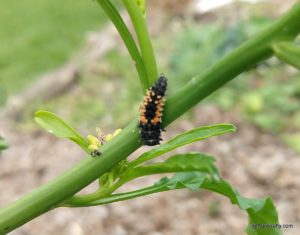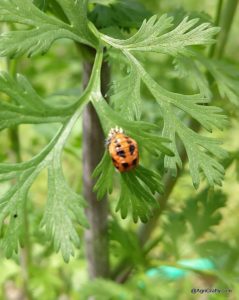Hi there, let’s talk about ladybugs for just a minute.
(I know, some say ladybird, but Lady Bird around Central Texas means the former first lady of the United States, Lady Bird Johnson, so ladybug it shall remain)
Hang on tight, it’s going to get sciencey for a bit. The scientific name for ladybugs is coccinellidae, which rhymes with…every other Latin name, which usually rhyme with “pretentious”, but are also incredibly useful. So, coccinellidae comes from the Latin “coccinella” which is the diminutive of “coccinus”, the latin word for scarlet, which actually comes from the Greek word “κοκκινος” (kokkinos) which is the diminutive of “κοκκος” (kokkos) which means berry! Just think about tiny red berries! I think it fits.
Also, you were right again, father-in-law from My Big Fat Greek Wedding, everything actually does come from Greek.
I’m going to stick to ladybug for now, but I’m sure you will switch to the Latin now that you know the whole story.
Ladybugs are fantastic in your garden, both as a sign of it being safe and pesticide free enough for them to live there, and because they are there to eat lots of aphids and other mites that “mite” be eating your vegetables.
A few weeks ago, I posted a picture of ladybugs in different stages of development in my garden and a well-meaning reader commented that they might not be ladybugs. So, this is to hopefully let everyone know that ladybugs have ugly duckling teenage years as well before they become the beautiful, charming, aphid munchers we all know and welcome into our gardens.
 Is this a lady bug? Yes, this is a ladybug in their rowdy in-between larval stage. They grow into this larva and you will see them crawling around looking pretty spiky and a little dangerous. This is when they engage in what the health profession calls “risky” behavior, including emo poetry, bad garage cover bands and tattoo choices they will regret.
Is this a lady bug? Yes, this is a ladybug in their rowdy in-between larval stage. They grow into this larva and you will see them crawling around looking pretty spiky and a little dangerous. This is when they engage in what the health profession calls “risky” behavior, including emo poetry, bad garage cover bands and tattoo choices they will regret.
 Is this a ladybug? Yes, again! This next stage is our friend, ladybug, while she is a pupa. (I say “she”, but there are males as well. I spoke with some, they are okay, culturally, with the use of that pronoun in this case)
Is this a ladybug? Yes, again! This next stage is our friend, ladybug, while she is a pupa. (I say “she”, but there are males as well. I spoke with some, they are okay, culturally, with the use of that pronoun in this case)
This pupa is the equivalent of a caterpillar going into a cocoon. During this time, in addition to having lots of time to think about the bad decisions they made in their larval stage, parts of their bodies dissolve and reshape as they grow those cute little scarlet berry shells and wings that we all recognize.
 And…we reach our final cute stage, the ladybug we all know and love. Obviously a ladybug and welcome in the garden to be cute, harmless and a voracious eater of smaller bugs that harass our plants.
And…we reach our final cute stage, the ladybug we all know and love. Obviously a ladybug and welcome in the garden to be cute, harmless and a voracious eater of smaller bugs that harass our plants.
With that, have a wonderful day! Be kind to lady bugs in any of these forms (even the awkward teenage ones) and enjoy the beautiful garden they are helping you to create.
Happy Growing,
E
